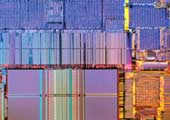| |
A Never-Ending Search for the New and Useful
 Materials research grew out of a union among physicists, chemists, engineers, metallurgists, and other scientists, including biologists. Today, the field has a body of literature and a research agenda of its own. NSF supports both experimental and theoretical research with three primary objectives: to synthesize novel materials with desirable properties, to advance fundamental understanding of the behavior and properties of materials, and to develop new and creative approaches to materials processing. Materials research grew out of a union among physicists, chemists, engineers, metallurgists, and other scientists, including biologists. Today, the field has a body of literature and a research agenda of its own. NSF supports both experimental and theoretical research with three primary objectives: to synthesize novel materials with desirable properties, to advance fundamental understanding of the behavior and properties of materials, and to develop new and creative approaches to materials processing.
Materials have been high on NSF's research agenda since the earliest days. In the 1950s, NSF built on the momentum of the World War II effort by making grants to the University of Akron to help researchers with their work on durable forms of rubber that could withstand elevated temperatures and pressures. Rubber belongs to the class of materials known as polymers, gigantic molecules made up of single units, or monomers, that link together in chains of varying lengths. Other naturally occurring polymers include complex carbohydrates, cellulose, proteins, spider silk, and DNA. For the Akron researchers, it was a smooth transition from rubber to an ever-widening range of synthetic polymers, examples of which are found today in products ranging from clothing and packaging to automobile and aircraft components.
In the center of what is now called "Polymer Valley," Akron
University's College of Polymer Science and Engineering houses a faculty
whose names are legendary in the world of rubber and plastic. Known
both for their own work—much of it funded by NSF—and for their students'
contributions to industry, these faculty members include Alan Gent and
Joseph P. Kennedy. Gent, an authority on deformation and fracture
processes in rubbery, crystalline, and glassy polymers, served on
the space shuttle redesign committee after the 1986 Challenger
disaster. Kennedy conducted some of the earliest research on
vulcanized rubber and has received two American Chemical Society
awards for pioneering work in polymer synthesis.
 Today's vibrant materials science community began its ascent in 1957.After the launch of Sputnik by the Soviet Union, the Department of Defense lobbied strenuously to make space-related research and technology a national priority. The effort gave birth to Interdisciplinary Laboratories (IDLs) under the Department of Defense's Advanced Research Projects Agency (DARPA). DARPA took a more integrated approach than did most universities at the time and brought together physicists, chemists, engineers, and metallurgists into collaborative research teams. They were encouraged to cross departmental boundaries and use systems approaches to attack complex problems of materials synthesis or processing. Graduate students trained in the IDLs accepted multidisciplinary research as the norm, which influenced the way they approached their own work. Today's vibrant materials science community began its ascent in 1957.After the launch of Sputnik by the Soviet Union, the Department of Defense lobbied strenuously to make space-related research and technology a national priority. The effort gave birth to Interdisciplinary Laboratories (IDLs) under the Department of Defense's Advanced Research Projects Agency (DARPA). DARPA took a more integrated approach than did most universities at the time and brought together physicists, chemists, engineers, and metallurgists into collaborative research teams. They were encouraged to cross departmental boundaries and use systems approaches to attack complex problems of materials synthesis or processing. Graduate students trained in the IDLs accepted multidisciplinary research as the norm, which influenced the way they approached their own work.
In 1972, DARPA transferred the management of the IDLs—600
faculty members at twelve universities—to NSF. NSF's
involvement gave even stronger emphasis to the multidisciplinary
team approach in the way funding opportunities were
defined.  "NSF
makes awards to the projects that look as if they will have the
most impact on science or technology, or both," explains
W. Lance Haworth, executive officer in the Division of Materials
Research, which is part of NSF's Directorate for Mathematical and
Physical Sciences. "Those projects typically involve people
from several disciplines. The field benefits from this approach—sparks
fly at the boundaries." "NSF
makes awards to the projects that look as if they will have the
most impact on science or technology, or both," explains
W. Lance Haworth, executive officer in the Division of Materials
Research, which is part of NSF's Directorate for Mathematical and
Physical Sciences. "Those projects typically involve people
from several disciplines. The field benefits from this approach—sparks
fly at the boundaries."
One of the best places to see "sparks fly" is at the Data Storage Systems Center, an NSF-supported Engineering Research Center (ERC) at Carnegie Mellon University in Pittsburgh. It is the largest academic research effort in recording technology in the United States. Engineers, physicists, chemists and material science researchers at the Carnegie Mellon Center are working together to increase dramatically the data storage capacity of computer systems. Among their goals, Center researchers aim to demonstrate the feasibility of 100 gigabits (100 billion bits) per square inch recording density for magnetic and optical recording systems by 2003—hundreds of times higher than the current industry standard.
 The Center recently made advances toward this goal by synthesizing two new materials. Each has led to the development of high-quality magneto-optic recording media for ultra-high densities. One is an artificially structured material made of very thin layers of platinum and cobalt. The other is a magnetic oxide. Both provide significantly improved performance over current systems. In a recent breakthrough experiment, researchers achieved recording densities of forty-five gigabits per square inch with platinum and cobalt films. The Center recently made advances toward this goal by synthesizing two new materials. Each has led to the development of high-quality magneto-optic recording media for ultra-high densities. One is an artificially structured material made of very thin layers of platinum and cobalt. The other is a magnetic oxide. Both provide significantly improved performance over current systems. In a recent breakthrough experiment, researchers achieved recording densities of forty-five gigabits per square inch with platinum and cobalt films.
Other NSF-supported centers also have taken on the challenge of advancing high-density storage media. The focus is on flexible storage media at the University of Alabama's Center for Materials for Information Technology, which is home to one of the 29 Materials Research Science and Engineering Centers (MRSEC) that NSF supports. The MRSECs stress pioneering materials research, education and outreach and they foster multidisciplinary collaborations between academia and industry. One interdisciplinary team at University of Alabama's MRSEC is studying the physical properties of granular films that have shown potential as a future low-noise, ultra-high density magnetic media. A second interdisciplinary team at the Alabama Center is exploring the functional limits of magnetic materials in high speed switching. The work could lead to the development of hard disk drive heads and storage media that are capable of operating at frequencies approaching a gigahertz.
Other sparks at the boundaries have developed into industry standards. For example, work on semiconductor lasers made the photonics revolution of the last three decades possible. Photonics uses light for signaling and conducting information along a pathway (electronics uses electrons for the same purpose). Researchers at several NSF-funded centers, including the Center for Materials Science and Engineering at the Massachusetts Institute of Technology, are continuing research into photonics, a field that has already produced compact disk players, laser printers, bar code readers, and medical applications, as well as new systems for displaying information.
|
|
